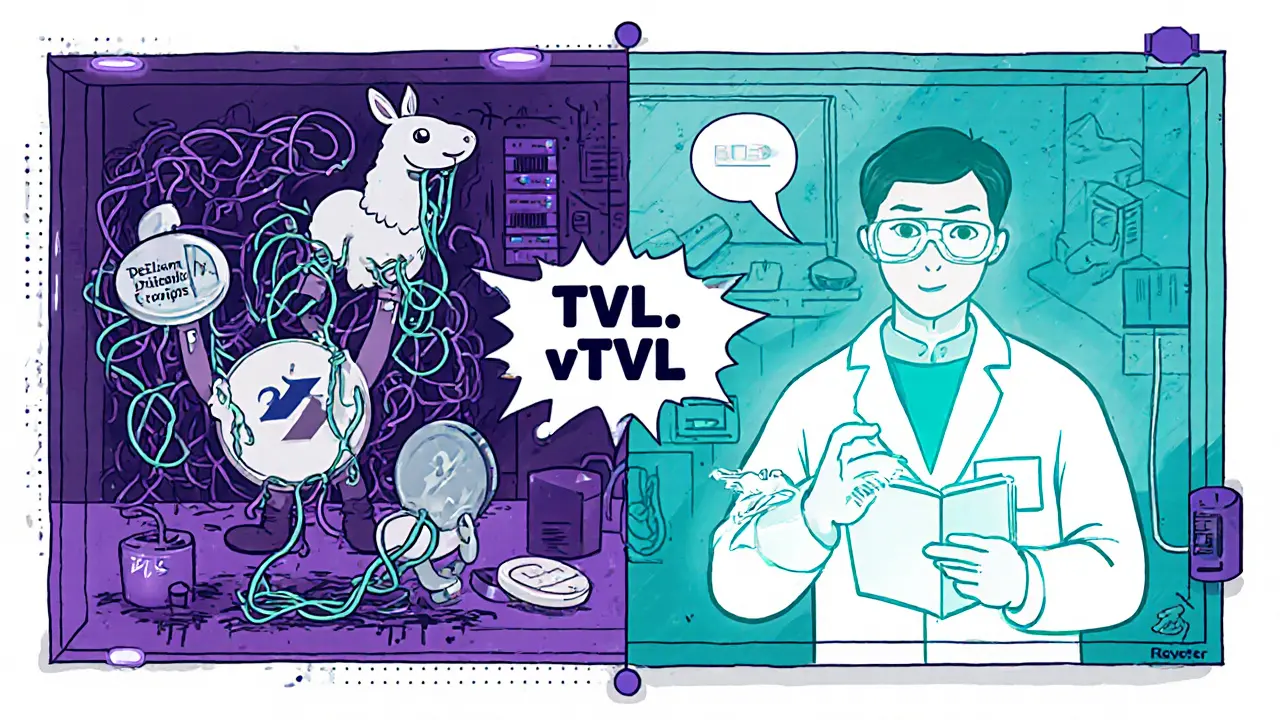TVL Changes and Trends in DeFi Explained
DeFi TVL Calculator
Results
Enter values and click Calculate to see TVL and vTVL figures.
Note: This calculator demonstrates how TVL and vTVL differ. Traditional TVL includes all reported balances, while vTVL uses only verified on-chain data. The discrepancy between the two metrics illustrates why vTVL is increasingly important for accurate DeFi analysis.
Ever wondered why the numbers on DeFi dashboards jump up one day and melt away the next? That roller‑coaster is driven by TVL, the metric that millions of investors and developers watch to gauge the health of the decentralized finance world.
What is TVL and why it matters
When you hear the term TVL is the total value locked, measured in US dollars, representing the combined value of assets secured in DeFi smart contracts, think of it as the "bank balance" of an entire ecosystem. A higher TVL usually signals strong user confidence, deeper liquidity, and a larger pool of capital that can be earned, borrowed, or traded without big slippage. Conversely, a dip can signal waning interest or a market‑wide sell‑off.
How TVL is calculated
At its core, TVL adds up every token sitting inside a protocol’s smart contracts. Imagine a lending platform that holds $125million of staked ETH, $56million of wrapped Bitcoin, and $20million of assorted ERC‑20 tokens. The TVL figure would read roughly $201million. The calculation pulls the latest market price for each asset, multiplies it by the amount locked, and sums the results. Because the price feed updates every few seconds, TVL can swing dramatically even if no new deposits or withdrawals occur.
Data sources and reliability issues
Most of us rely on aggregators like DeFiLlama (a real‑time TVL data provider that scrapes on‑chain balances across dozens of blockchains) or CoinGecko (a crypto market data platform that also publishes TVL figures for major protocols). While convenient, these services often depend on community‑submitted scripts and may miss edge cases like cross‑chain bridges or off‑chain accounting.
A 2023 study by the Bank for International Settlements (the global central bank consortium that researches financial stability) examined 939 Ethereum DeFi projects and found that roughly 10% relied on external servers for balance data, and 68 different query methods were in use. The lack of a single, verifiable standard means the TVL numbers you see could be off by a sizeable margin.

Introducing verifiable TVL (vTVL)
To address those gaps, researchers coined the term vTVL (verifiable Total Value Locked, a metric calculated strictly from on‑chain balance queries using standardized methods). In a pilot covering 400 protocols, vTVL matched published TVL numbers for just 46.5% of cases, exposing substantial discrepancies in the traditional approach.
Comparing TVL and vTVL
| Aspect | TVL (traditional) | vTVL (verifiable) |
|---|---|---|
| Data source | Mix of on‑chain, off‑chain, community scripts | Pure on‑chain balance queries |
| Transparency | Often opaque, depends on self‑reporting | Open, auditable by anyone |
| Standardization | Multiple methods, inconsistent across protocols | Single, documented query standard |
| Typical variance with market price | High - price moves affect TVL instantly | Same - price impact still present, but calculation is uniform |
| Adoption | Widely used by dashboards and media | Emerging, gaining traction among researchers |
Key factors that move TVL numbers
- Market volatility: A 10% drop in ETH price immediately reduces the USD‑denominated TVL of any ETH‑centric protocol.
- New protocol launches: Incentive programs (yield farming, liquidity mining) can attract rapid inflows, spiking TVL within days.
- Layer‑2 adoption: Solutions like Arbitrum (a Layer‑2 scaling rollup for Ethereum that reduces fees and speeds transactions) bring cheaper gas, encouraging users to move assets off‑chain, which shows up as a TVL increase on the Layer‑2.
- Regulatory news: Positive regulatory signals can trigger fresh capital, while harsh news can trigger mass withdrawals.
- Stablecoin supply: Since many protocols lock USDT, USDC, or DAI, a surge in stablecoin minting directly inflates TVL figures.

Using TVL trends for investment decisions
- Check the direction of TVL over the past 30days. Consistent growth often correlates with user adoption.
- Validate the source. Prefer platforms that publish their query scripts or use vTVL where available.
- Overlay TVL with token price. A protocol whose TVL is rising while its token price is flat may indicate undervaluation.
- Assess incentive sustainability. High TVL driven solely by short‑term rewards can slump once rewards decay.
- Cross‑compare with peers. For example, Aave (a leading lending protocol on Ethereum with a diversified pool of assets) and EigenLayer (a restaking platform that lets users double‑stake assets for additional rewards) often serve as benchmarks for the lending niche.
Current trends and future outlook
The community is moving toward more transparent measurement. Discussions on forums and at conferences now frequently mention “vTVL‑first” dashboards. Academic proposals from the BIS suggest a universal query language that could become the de‑facto standard by 2026. If that happens, investors will have a single, reliable yardstick to compare Ethereum, Cardano (a proof‑of‑stake blockchain that emphasizes formal verification), Cosmos, and emerging Layer‑2s.
In the meantime, keeping an eye on TVL spikes around major events-protocol upgrades, token launches, or macro‑economic shifts-will still give you a solid edge. The metric isn’t perfect, but its evolution toward verifiability reflects the growing maturity of DeFi as a financial sector.
Frequently Asked Questions
How often is TVL updated?
Most aggregators refresh TVL every 5‑10 seconds using live price feeds, so the number you see can change several times per minute.
Can TVL be manipulated?
Yes. Pump‑and‑dump of a single token, self‑reported balances, or using side‑chains that aren’t tracked can inflate TVL artificially.
What’s the difference between TVL and market cap?
Market cap measures the total value of a token’s circulating supply, while TVL measures the value of assets actually locked in a protocol’s smart contracts.
Why should I care about vTVL?
vTVL removes off‑chain guesswork, giving you a cleaner, auditable number that’s harder to spoof, which is vital for serious risk assessment.
Do all blockchains report TVL the same way?
No. Ethereum dominates the data space, but chains like Solana, Binance Smart Chain, and Cosmos have their own aggregators and sometimes use different token valuation methods.






13 Comments
Andrew Lin
October 8 2025TVL numbers are fake, real power lies in US blockchain dominance!
Richard Bocchinfuso
October 14 2025i cant believe ppl still think vTVL is just a buzzword, it matterss.
Melanie LeBlanc
October 20 2025Hey everyone, great breakdown! It’s crucial to remember that the traditional TVL can be inflated by unverified bridges, while vTVL gives us a cleaner picture of actual on‑chain value. Using both metrics together helps spot over‑leveraged protocols and assess real risk exposure.
Don Price
October 26 2025When you look at the DeFi ecosystem, you have to consider that every metric is being gamed by some hidden agenda. The TVL figures are often bloated by wrapped tokens that never move off‑chain, creating an illusion of liquidity that disappears in a flash‑crash. vTVL tries to correct that by only counting verified assets, but even that is not immune to manipulation – think about oracle attacks and phantom balances. Moreover, the centralization of data feeds means a single point of failure can corrupt the whole picture. Some protocols even create synthetic assets that inflate the numbers without real economic activity. It’s also worth noting that many analytics platforms cherry‑pick data points that make their dashboards look impressive, ignoring the messy reality underneath. The crypto community has a tendency to cling to headline numbers while ignoring the underlying fundamentals, and that is a dangerous habit. If you dive deeper, you’ll find that a large portion of the “locked” value is actually just liquidity that can be withdrawn instantly, offering no real security to users. The distinction between TVL and vTVL is not just academic; it reflects the maturity of the market and the necessity for better risk models. In short, while vTVL is a step forward, we must stay skeptical and continue developing more robust verification methods, otherwise we’ll keep repeating the same cycles of hype and bust.
Jasmine Kate
November 1 2025The latest TVL chart looks like a total scam – numbers are soaring overnight without any real user adoption, just a bunch of bots pumping the stats.
Mark Fewster
November 7 2025Interesting point, however, the sudden spikes could also be attributed to new liquidity mining programs; we should examine the underlying transaction data before jumping to conclusions.
Dawn van der Helm
November 13 2025Love the deep dive! 🚀 Keeping an eye on vTVL really helps us stay ahead of the curve. 🌟
Monafo Janssen
November 20 2025Thanks for the insight! It’s good to see data presented in a simple way so even newcomers can get the gist.
Michael Phillips
November 26 2025From a philosophical standpoint, the pursuit of perfect metrics mirrors our quest for certainty in an inherently uncertain market; therefore, each new measure should be viewed as a stepping stone rather than an absolute truth.
Jason Duke
December 2 2025Great tool! Using both TVL and vTVL gives a clearer picture of protocol health and helps investors make smarter decisions.
Franceska Willis
December 8 2025i think the calculator is le epic but some numbers look off, maybe cuz of typo in the input fields?
Matthew Laird
December 14 2025American projects lead the way in true on‑chain value; we should celebrate US‑based developers when they push vTVL numbers higher than the rest of the world.
Patrick Gullion
December 20 2025While patriotism is admirable, focusing solely on geography ignores the global nature of decentralized finance and the innovative work happening elsewhere.